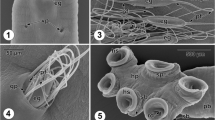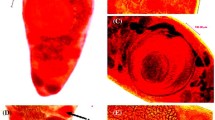Abstract
The surface topography of three cestode parasites from the gut ofSqualus acanthias is described with the aid of scanning electron microscopy (SEM). The cestodes areTrilocularia acanthiaevulgaris, which occurs in both stomach and spiral valve, andPhyllobothrium squali andGilquinia squali, which only appear in the latter. Differences between the stomach and spiral valve forms ofT. acanthiaevulgaris are recorded. The anterior third of the free proglottis of this species is covered by numerous large, backwardly-projecting spines. Bands of similar, though smaller, spines encircle the anterior margins of proglottides still attached to the strobila and grow larger as the proglottides mature. The adherent surface of the bothridia ofP. squali is covered by large numbers of minute “ear-of-corn” projections, in addition to more normal microtriches, whilst that ofG. squali bears numerous flat, plamate structures. The mature and free proglottides ofG. squali possess large numbers of short, rod-like structures around the genital pore and they are surrounded by a ring of hummock-like papillae. The possibilities of these microtopographical features being used in a sensory and/or attachment role are considered. The value of SEM as a taxonomic aid in cestode systematics is briefly discussed.
Similar content being viewed by others
References
Andersen K (1975) Comparison of surface topography of three species ofDiphyllobothrium (Cestoda, Pseudophyllidea) by scanning electron microscopy. Int J Parasit 5:293–300
Baer JG, Euzet L (1955)Prosobothrium armigerum Cohn 1902 (Cestoda). Historique, synonymie, description et position systématique. Exptrait Rec Trav Lab Bot Geol Zool Univ montpellier 1:44–55
Euzet L (1952) SurTrilocularia acanthiae-vulgaris (Olsson 1867) Cestoda, Tetraphyllidea. Bull Inst océanogr Monaco no, 1010:1–6
Fuhrmann O (1931) Cestoidea. Handb d Zool von Kük II:141–416
Halton DW, McKerr G (1979) SEM observations on the spiral valve of rays and their cestode parasites. Parasitology 79(3) xlvii
Lineaweaver TH, Backus RH (1970) The natural history of sharks. André Deutsch, London, pp 151–153
Lühe M (1902) Über einem eigenthümlichen Cestoden aus Acanthias,Urogonoporus armatus. Arch paras TV: 209–250
Manger BR (1967) Some cestode parasites of the elasmobranchsRaja batis andSqualus acanthias from Iceland. Bull Br Mus nat Hist (Zool) 24(3):161–181
McVicar AH (1972) The ultrastructure of the parasite-host interface of three tetraphyllidean tapeworms of the elasmobranchRaja naevus. Parasitology 65(1):77–88
Mokhtar-Maamouri F, Swiderski Z (1975) Etude en microscopie électronique de la spermatogénèse de deux cestodes,Acanthobothrium fillicole benedenii Loennberg, 1889 etOnchobothrium uncinatum (Rud., 1819) (Tetraphyllidea, Onchobothriidae). Z Parasitkd 47:269–281
Mokhtar-Maamouri F, Swiderski Z (1976) Vitellogenesis inEcheneibothrium beauchampi Euzet, 1959 (Cestoda; Tetraphyllidea; Phyllobothriidae). Z Parasitkd 50(3):293–302
Odhner T (1904)Urogonoporus armatus Lühe 1902 die reifen proglottiden vonTrilocularia gracilis Olsson 1896. Arch Paras 8:465–471
Olsson P (1867) Entozoa iakttagna hos skandinaviska hafsfiskar. I. Platyhelminthes. Lunds Univ Arsskr, Ard Math o Naturv-Vetensk 3:1–59
Rees G (1953) Some parasitic worms from fishes off the coast of Iceland. I. Cestoda. Parasitology 43:4–14
Rees G, Williams HH (1965) The functional morphology of the scolex and the genitalia ofacanthobothrium coronatum (Rud.) (Cestoda, Tetraphyllidea). Parasitiology 55:617–651
Southwell T (1925) A monograph on the Tetraphyllidea (with notes on related cestodes). Mem Liverpool school Trop Med NS Liverpool University Press, pp 166–169
Wardle RA, McLeod JA and Radinovsky S (1974) Advances in the zoology of tapeworms 1950–1970. University of Minnesota Press: Minneapolis
Whittaker FH (1976) Parasite-host relationships: A study in adaptation. Biol Digest 3:11–20
Whittaker FH, Carvajal GJ (1980) Scanning electron microscopy of scolices of some cestodes from elasmobranchs. Proc Helminthol Soc Wash 47:256–259
Whittaker FH, Carvajal GJ, Apkarian R (1982) Scanning electron microscopy ofGrillotia dollfusi Carvajal 1971 (Cestoda: Trypanorhyncha). J Parasitol 68:1173–1175
Williams HH (1966) The ecology, functional morphology and taxonomy ofEcheneibothrium Beneden, 1849 (Cestoda: Tetraphyllidea), a revision of the genus and comments onDiscobothrium Beneden, 1870,Pseudanthobothrium Baer, 1956, andPhormobothrium Alexander, 1963. Parasitology 56:227–285
Williams HH (1968) The taxonomy, ecology and host-specificity of some Phyllobothriidae (Cestoda: Tetraphyllidea), a critical revision ofPhyllobothrium Beneden, 1849 and comments on some allied genera. Phil Trans Roy Soc London B253:231–307
Yamaguti S (1952) Studies on the helminth fauna of Japan, 49. Cestodes of fishes II. Acta Med Okoyama 8:1–76
Yamaguti S (1959) Systema Helminthum. II. Cestodes of vertebrates. Interscience Publishers
Young JZ (1933) The preparation of isotonic solutions for use in experiments with fish. Publicazioni della Stazione Zoologica di Napoli 12:425–431
Author information
Authors and Affiliations
Rights and permissions
About this article
Cite this article
McCullough, J.S., Fairweather, I. A SEM study of the cestodesTrilocularia acanthiaevulgaris, Phyllobothrium squali andGilquinia squali from the spiny dogfish. Z. Parasitenkd. 69, 655–665 (1983). https://doi.org/10.1007/BF00926675
Accepted:
Issue Date:
DOI: https://doi.org/10.1007/BF00926675




